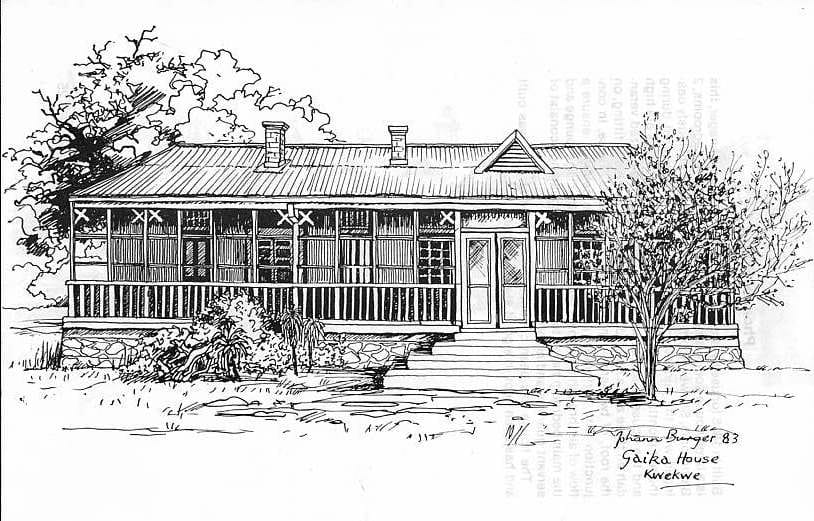Down in the Dumps

Gaika House, the mine managers residence, was built before the turn of the twentieth century. Leased by Round Table for a nominal fee after the mine closed in 1976, it was later sold to Dr. Richard Edwards for £1.0.0. on condition that the exterior be preserved. He moved it to his farm.
Down in the Dumps
The Chicago-Gaika Development Co. was launched in 1897 and issued 200,000 shares of one pound each. The shares were fully subscribed. It acquired 437 gold claims in the Sebakwe district. One hundred of these claims, were apparent extensions of the Globe and Phoenix Mines.
Down in the Dumps
Phoenix Mine started production in 1900, the Gaika getting off to a slow start in 1905, reportedly due to the “unsporting behavior of the Globe and Phoenix which hauled their machinery up from Bulawayo by ox cart in the wet season making the roads impassable for years.” However the Beira and Mashonaland Railway reached the G and P Station November 5th 1901 from Salisbury and on to Bulawayo by December 1902, giving rail access to both east and south coasts, so the state of the roads couldn’t have been the cause of delay.
Drinking water was hauled from the Sebakwe River by ox wagon but after a legal wrangle in 1898 the G and P obtained permission to pump water via a five and a quarter mile pipeline from the Sebakwe River. However during the drought of 1904 Gaika employees walked to the G and P with four gallon paraffin tins to get their water. As it persisted the Globe and Phoenix forbade employees to give out water from its shaft to the Gaika.
The Gaika got little encouragement from the Government Mining Engineer either. He reported “The Chicago-Gaika as a whole must be regarded as a disappointing proposition…none of the ore bodies thus far discovered give any indication of permanency or size… It has been proposed to erect a battery and fifteen stamp mill. If the future of the mine were assured and there was a probability of the mine lasting for five or ten years then [this investment] would be advisable, but for a property, the future of which is so uncertain, I do not think it would be wise.”
As predicted, the mine was plagued with irregular reefs. Instead of one continuous channel, there were sub-parallel or even transgressive ore bodies with variable pay-shoot and sudden cut-offs on their North Reef, Parallel Lode, and Rubble Reefs to the north and Lucy and Lucy West, Magazine, Number’s 6, 8, and 10, South Kopje, Robin Hood, and its Extension. The saving grace was high grade was maintained. But expenses were high, the North Reef having a very high antimony content.
“The mine always gave cause for anxiety, as a result of which large scale operations were avoided. There was difficulty in estimating ore reserves accurately, and linking the sampling plans to mill throughput to ore reserves… Blocks of ore which should, on paper, have done well were poor and others, considered marginal, often yielded surprisingly good results.”
Nevertheless, Gaika House was built for the first manager and his successors, on the highest point in the area, Gaika Kopje. Naturally, it was smaller but bore striking resemblance to the sprawling Phoenix House. “At the foot of Gaika Kopje some very rich ore was encountered in the earliest prospectus shafts: amber-colored steatite flecked through with the gold carrying about 100 ounces to the ton! A drive was put out on this for about 150 ft. north and south. The rich product was stored in a pole and dagga (wattle and daub) hut at the bottom of the garden. A caretaker was installed.
“By the time the mining engineer arrived to take over more active operations the caretaker firmly believed the hoard to be his own and was difficult to dislodge. The engineer was of the opinion that much of the gold had been hidden under adjacent development rock dumps.”
The house has been moved. However, the gold might still be there…
Thanks to Bob Atkinson for many mining articles as well as a copy of the booklet Some Historic Buildings of the Central Region from which the pen and ink by Johann Burger ’83 is reprinted.
On a personal note: My son, Andrew Davis has pipped me to the post on publishing his book Bransdscaping Unleashing the Power of Partnerships. The first 100 signed pre-order copies sold out in 7 hours but you can still order a discounted copy at https://www.brandscapingbook.com/brandscaping-pre-orders-sold-out/ The books will ship Aug 26.
I’ve been lucky enough to read the galley proof. It’s a terrific read whether you are a mother or grandmother helping your child or grandchild sell M & M’s door to door or a manager of Microsoft or anything in-between. If you are retired you will never view advertising in quite the same light. Andrew inherited all the out-of-the-box creative thinking, problem solving genes and boundless energy of his maternal grandfather. Exhaustively researched the book is chock full of fascinating anecdotes from every type of industry followed by what if to think bigger.
Perhaps I’m biased! Here are some professional comments:
Download the pre-release table of contents and introduction: (BTW, please don’t distribute this freely. It’s from the layout version and hasn’t gone through final approvals and proofing.)
Enjoy!
